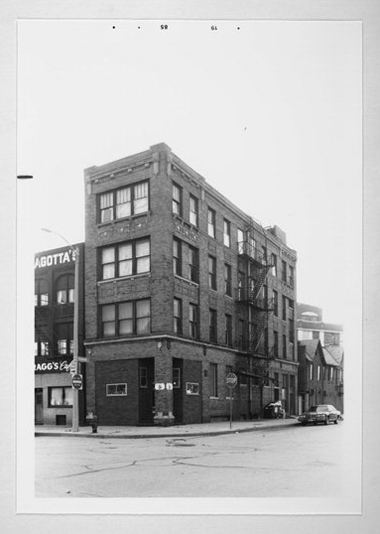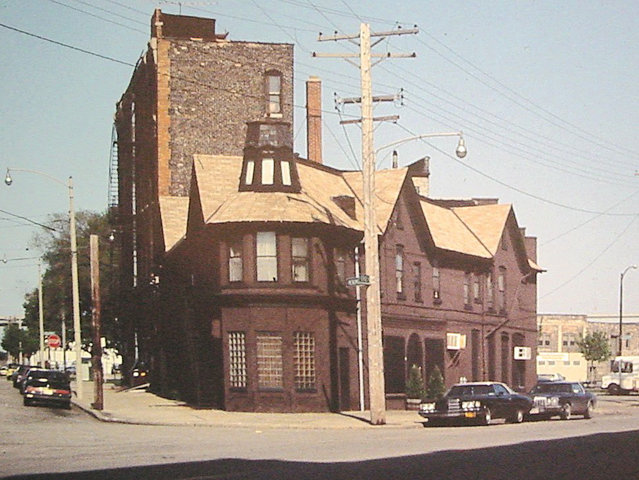Last week, The Business Journal’s Sean Ryan wrote about neighborhood efforts to prevent the destruction of a pair of buildings on the triangle at the foot of Broadway in the Third Ward.
General Capital Group and Joseph Property Development bought the properties from Milwaukee Institute of Art and Design in September and unveiled plans to clear the site and build a mixed-use development with retail, apartments and a commons space for MIAD students to replace one of the buildings, which had served as the school’s student union.
Two of the three are threatened with destruction.
The three-story brick building at 143 N. Broadway, built in 1902 and designed by architect Andrew Elleson, was initially the home of Norwegian immigrant John H. Steinkopf’s shop. Opened in 1878, Steinkopf & Sons Tents & Awnings specialized in canvas and products like haystack covers, boat sails, awnings, horse and wagon covers, tents, banners and flags.
In 1915, a candymaker occupied the building, but Milwaukee Italian-Americans remember it best as Frank Dragotta’s tavern, which endured from the 1950s until the mid-1990s.

(Photo: Wisconsin Historical Society)
Though the building bears a historical marker describing the Caradaro Club, owned by John Caravella and Joe Todaro, which was the first Milwaukee restaurant to dish up pizza, in 1945 (ignore the plaque’s assertion that pizza was making its way to America at that time; it was already long established in cities with larger Italian enclaves), the restaurant was actually across the street at 326 E. Erie St. The site is now a surface parking lot.

(Photo: Milwaukee Public Library)
After Dragg’s closed, Cafe Marche opened in the space, which later housed an art supply store. Residences occupy the two upper floors.
The four-story warehouse next door, at 147 N. Broadway, was built in 1911 for Clemens H. Kavelage based on designs by Carl Ringer. Both these buildings face onto Catalano Square. Razing this one is not part of the plan at the moment. (This building is now home to attorney Jay Urban's office, which I later wrote about here.)

(Photo: Wisconsin Historical Society)
Though the main floor most recently housed a salon – like its neighbor, the upper floors are residential units – throughout its history, the building has been a warehouse for business like coffee wholesaler Koehler-Clemens, Forster Label Works and H.F. Auler Co., which sold hobby supplies like model cars, glue and stamp collecting materials.
To the west of these buildings is perhaps the most interesting structure, a triangular building at 266 E. Erie St., that until a 2013 fire, served as the MIAD student union. All three buildings, incidentally, were added to the National Register of Historic Places in 1984 and to the state's register five years later.

After the Third Ward fire, there were a lot of vacant lots in the area.
But this attractive and unusual Queen Anne structure – one of just a handful of buildings to survive the devastating fire that basically erased the area in 1892 – has a long history as a saloon.
The structure was built in 1884 and designed by unknown architect.
The saloon was built by Catherine Foley, a widow who operated a tavern nearby. On March 19, 1884, she paid for a permit to build, "a $3,000 brick house."
"This begs the question of how Catherine Foley was able to afford the construction of this building, given her widowed status," posits a 2014 City of Milwaukee Historic Preservation Commission report on the building. "At this time in this part of the Third Ward, masonry
buildings were not that common and were expensive to build.
Perhaps Catherine had assistance from members of her husband’s family or her own family, the Magies. Perhaps she was able to leverage a mortgage on the property at 112 Erie Street or perhaps she sold that other property. A look at the fire insurance maps shows that Catherine’s building was the only masonry building used as a boarding house and saloon in the vicinity constructed at this time period. Catherine Foley chose her location well. The distinctive turret on her building and its rounded corner made for a building that was easily seen at the intersection of two streets and it was far more imposing than the frame structures around her."
Though she didn't stay long – moving to Jackson Street by 1887 – Foley kept the building and rented it to other saloonkeepers, including John Blum (1888), Frank Belberick (1889), John Betz (1891) and James McCarthy (1892-1893).
It's possible there was also at least one other saloonkeeper during that time, as in July 1891 William Murphy applied to the Common Council for a license to sell "vinous, spiritous, malt, ardent or intoxicating liquors or drinks in quantities less than one gallon, to be drank on the premises."
In 1894, Foley sold the building to J.M. Pereles.
"Her building had been spared destruction in the Third Ward fire of 1892 but it is possible that the devastation around her building led to her decision to sell," notes the city report. "Or perhaps developers, eager to take advantage of the devastation, made an offer she couldn’t refuse."
In 1896, the triangular spot was sold to Miller Brewing Co., who continued leasing it to Cornelius Murphy (who had been there since 1894) until 1906.
Among the tavernkeepers during the following era were Joseph Kernz (1907), Joseph Kermec (1908), Frank Franchich (1909-1910), Mrs. May Holcomb (1911) and Mary O’Donnell (1912).
The east addition was put on in 1912 by mason August Buchholz, and was designed by Miller's favorite architects Wolff & Ewens.
According to Miller Brewing Company records, the saloon was operated in 1917 by August Sell and had a book value of $13,315.32, which was pretty impressive.
The taverns on Miller's handwritten tied house spreadsheet that year were valued more typically in the the range of $4,000 to $10,000. Some very rare examples, however, could be worth $45,000 to $65,000.
In June 1918, Hungarian immigrant Mark Rechnitzer applied for a liquor license for the business, but it's unclear whether or not he got it. If so, he didn't serve long as a saloonkeeper there (Prohibition loomed, after all).
By May 1920, Rechnitzer was running a place at 64 12th St., where he was nabbed for illegally possessing liquor, a charge he was also indicted on two months earlier, and which may have ended his career behind the bar. Later records suggest Rechnitzer had a number of jobs unrelated to saloons.
Just before Prohibition, Miller moved the property to its real estate arm, Oriental Investment Company, and ended up selling it in 1922 to John Mortle, who had been Oriental's tenant.
Mortle died in August 1925 and later owners tended to stay awile. John and Anna Walker were there from the 1930s until arond 1949 and John Halser arrived in 1951 and stayed until 1972.
Early in his tenure, Halser obtained a permit to operate a nine-room boarding house with a capacity of 13 roomers, suggesting that the building had maintained this use since its earliest days.
 (Photo: Google Maps)
(Photo: Google Maps)
From 1972 to 1996, the building was home to the now-legendary Wreck Room Bar, described in this detailed history as "Milwaukee’s first cowboy/levi-leather bar."
Opened by Wayne Bernhagen, the bar was the birthplace of the Silver Star Motocycle/Leather Club and the home to a wooden cart with a hitch carved to resemble an erect penis. When The Wreck Room closed, the cart was moved to Woody’s.
When the bar closed, after a big street festival in celebration of its history, MIAD purchased it and re-tooled it as its student union.
Then there was the fire, and the place has been mostly unloved since then.
Most of the interior is demolished but outside most of the tower remains; only the flag pole appears to have been removed.
Born in Brooklyn, N.Y., where he lived until he was 17, Bobby received his BA-Mass Communications from UWM in 1989 and has lived in Walker's Point, Bay View, Enderis Park, South Milwaukee and on the East Side.
He has published three non-fiction books in Italy – including one about an event in Milwaukee history, which was published in the U.S. in autumn 2010. Four more books, all about Milwaukee, have been published by The History Press.
With his most recent band, The Yell Leaders, Bobby released four LPs and had a songs featured in episodes of TV's "Party of Five" and "Dawson's Creek," and films in Japan, South America and the U.S. The Yell Leaders were named the best unsigned band in their region by VH-1 as part of its Rock Across America 1998 Tour. Most recently, the band contributed tracks to a UK vinyl/CD tribute to the Redskins and collaborated on a track with Italian novelist Enrico Remmert.
He's produced three installments of the "OMCD" series of local music compilations for OnMilwaukee.com and in 2007 produced a CD of Italian music and poetry.
In 2005, he was awarded the City of Asti's (Italy) Journalism Prize for his work focusing on that area. He has also won awards from the Milwaukee Press Club.
He has be heard on 88Nine Radio Milwaukee talking about his "Urban Spelunking" series of stories, in that station's most popular podcast.







